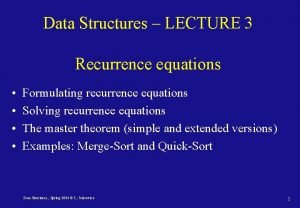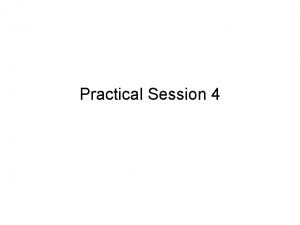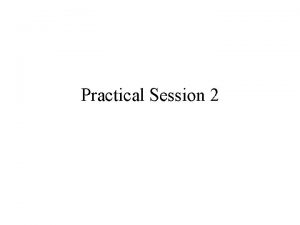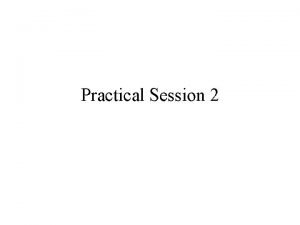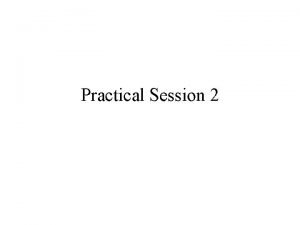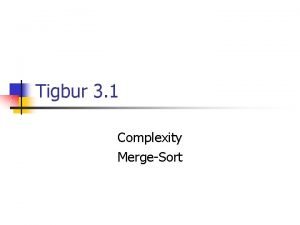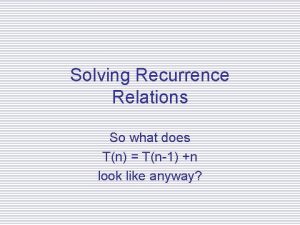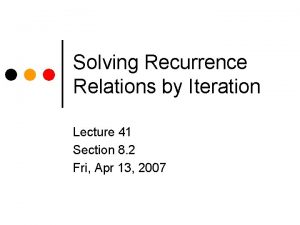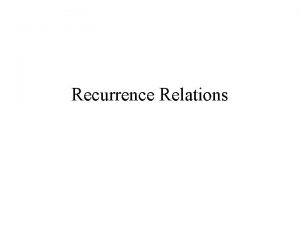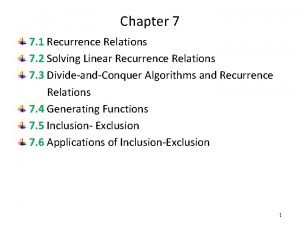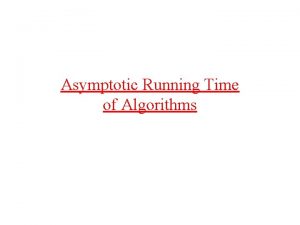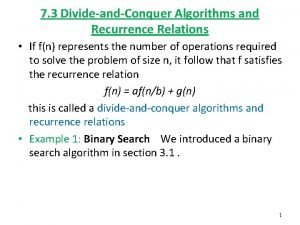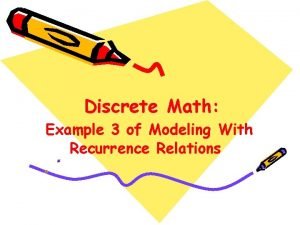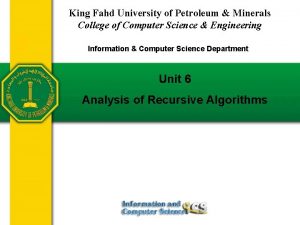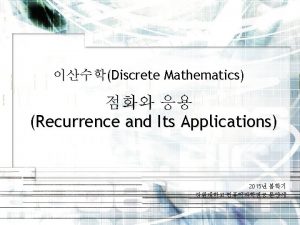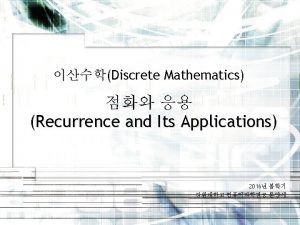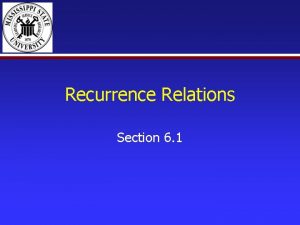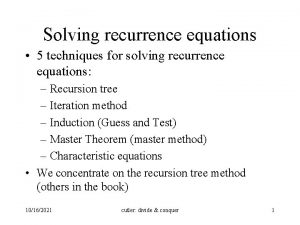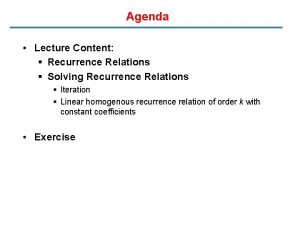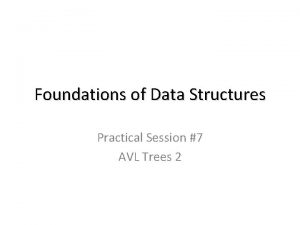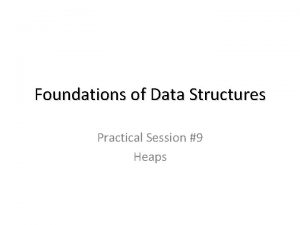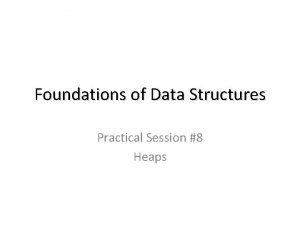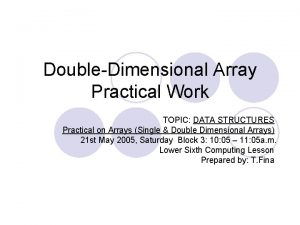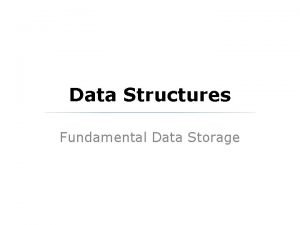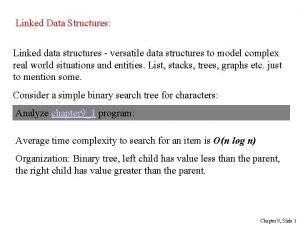Foundations of Data Structures Practical Session 4 Recurrence

















![Question 3 cont’d • Insert (x, k) { A[k] = x count++ } remove Question 3 cont’d • Insert (x, k) { A[k] = x count++ } remove](https://slidetodoc.com/presentation_image_h2/9bacfd5d379429f1474f41482972a66b/image-18.jpg)

![Question 4 cont’d • flip(i, j) if (A[i][j] == 0) { if (Sum[i] == Question 4 cont’d • flip(i, j) if (A[i][j] == 0) { if (Sum[i] ==](https://slidetodoc.com/presentation_image_h2/9bacfd5d379429f1474f41482972a66b/image-20.jpg)


- Slides: 22

Foundations of Data Structures Practical Session #4 Recurrence ADT 08/04/2013 Amihai Savir & Ilya Mirsky - 2013

Recurrence solution methods 2

The master method 3

Master method example 4

Example cont’d 5

Example cont’d 6

ADT From Wikipedia: • In computer science, an abstract data type (ADT) is a mathematical model for a certain class of data structures that have similar behavior. • An abstract data type is defined indirectly, only by the operations that may be performed on it and by mathematical constraints on the effects (and possibly cost) of those operations. 7

Vector (Array) 8

Queue FIFO - First In First Out ADT that supports the following operations: • enqueue(element) – inserts new element at the tail of the queue. • dequeue() – removes and returns an element from the head of the queue. • peek() eek – (optional) returns an element from the head of the queue, without removing it. • is. Empty() – returns true if the queue is empty, 9

Stack LIFO - Last In First Out ADT that supports the following operations: • push(element) – adds an element to the head of the stack. • pop() – removes and returns an element from the head of the stack. • top() – (optional) returns the element from the head of the stack, without removing it. • is. Empty – returns true if the stack is empty. 10

Linked List • A data structure that supports linear access to its elements. • Each element points to the next element in the list. • In a doubly-linked list: each element has 2 pointers, one to the next element in the list and the other to the previous element. 11

Question 1 Suggest 2 ways to implement a Queue using 2 Stacks. Solution • • • Notice that the queue/stack is abstract, meaning the implementation isn't known, only the interface. In order to implement a queue we need to implement the following methods: enqueue(x), dequeue(), is. Empty() We will use stack A to hold the queue's elements and stack B as a temporary stack. We will use the Stack ADT operations: push(x), pop() and is. Empty(). 12

Question 1 cont’d enqueue (x) { move. Elements(A, B) A. push(x) move. Elements(B, A) } dequeue ( ) { element = A. pop() return element } is. Empty ( ) { return A. is. Empty() } move. Elements(X, Y) { while (! X. is. Empty()){ temp = X. pop() Y. push(temp) } } * In a very similar manner one can implement stack using 2 queues. 13

Question 1 cont’d Another solution enqueue (x) { move. Elements(A, B) A. push(x) } is. Empty ( ) { return (A. is. Empty() && B. is. Empty()) } dequeue ( ) { move. Elements(B, A) element = A. pop() return element } 14

Question 2* Suggest a way to implement a Stack using Linked List. Solution We will use an inner List L in order to hold the stack’s elements. 15

Question 2 cont’d pop() { element ← L. item. At(0) L. remove. Item. At(0) return element } push(x) { L. add. To. Head(x) } top() { element ← L. item. At(0) return element } is. Empty() if L. size()=0 then return true else return false } 16

Question 3* Operation init(n) is. Element(k) insert(x, k) remove(k) is. Empty() has. All () Time O(n) O(1) O(1) 17
![Question 3 contd Insert x k Ak x count remove Question 3 cont’d • Insert (x, k) { A[k] = x count++ } remove](https://slidetodoc.com/presentation_image_h2/9bacfd5d379429f1474f41482972a66b/image-18.jpg)
Question 3 cont’d • Insert (x, k) { A[k] = x count++ } remove (k) { A[k] = null count-} is. Empty () { return (count == 0) } has. All () { return (count == n) } 18

Question 4 init(n) flip(i, j) has. Row. Of 1() has. Row. Of 0() Operation Initialize A with the value 1 Flip the value in A[i, j], i. e. , A[i, j] = !A[i, j] Return true iff A has a row that contains only 1 -s Return true iff A has a row that contains only 0 -s Time O(n 2) O(1) 19
![Question 4 contd flipi j if Aij 0 if Sumi Question 4 cont’d • flip(i, j) if (A[i][j] == 0) { if (Sum[i] ==](https://slidetodoc.com/presentation_image_h2/9bacfd5d379429f1474f41482972a66b/image-20.jpg)
Question 4 cont’d • flip(i, j) if (A[i][j] == 0) { if (Sum[i] == 0) count 0 - Sum[i]++ if (Sum[i] == n) count 1++ A[i][j] = 1 } else { if (Sum[i] == n) count 1 - Sum[i]-if (Sum[i] == 0) count 0++ A[i][j] = 0 } 20

Question 5 Operation Time add(k, is. Special) O(n) remove. Min() remove. Max() O(1) get. Oldest() Returns the oldest special number, according to insertion order O(1) 21

Question 5 cont’d 22
 Recurrence data structures
Recurrence data structures Factor label definition
Factor label definition Multipicand
Multipicand Practical session meaning
Practical session meaning Practical session meaning
Practical session meaning Foundations and earth retaining structures
Foundations and earth retaining structures Homologous structures example
Homologous structures example Recurrence relation merge sort
Recurrence relation merge sort Recurrence rate
Recurrence rate Recurrence relation for linear search
Recurrence relation for linear search Recurrence relation solver
Recurrence relation solver Linear homogeneous recurrence
Linear homogeneous recurrence Master theorem
Master theorem Common recurrence relations
Common recurrence relations Recurrence computer science
Recurrence computer science Hsv-2 oral transmission rates
Hsv-2 oral transmission rates Recurrence relation
Recurrence relation Asymptotic cheat sheet
Asymptotic cheat sheet Algorithm recurrence relation
Algorithm recurrence relation Unrolling the recurrence
Unrolling the recurrence Recurrence relation exercises
Recurrence relation exercises Recurrence discrete math
Recurrence discrete math Recurrence relation of recursive selection sort
Recurrence relation of recursive selection sort
